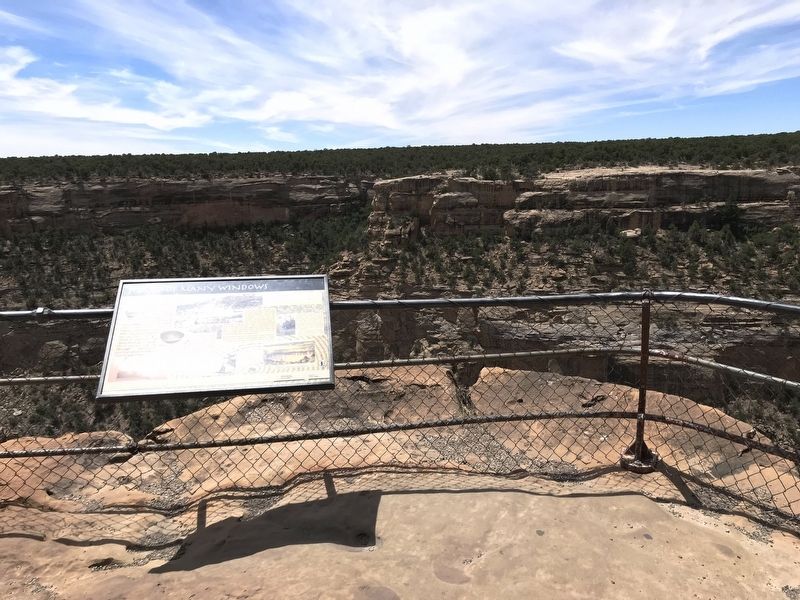Mesa Verde National Park in Montezuma County, Colorado — The American Mountains (Southwest)
House of Many Windows
The Ancestral Puebloans may have worked hard to survive here, but their lives were adorned with beauty and creativity. Intricately woven baskets, ornately decorated pottery, and colorfully plastered interiors speak of leisure time and careful concern for aesthetic design. While the inhabitants of these dwellings are gone, their works live on through the admiration and inspiration of modern writers and artists.
"From the ancient dwelling there came always a dignified, unobtrusive sadness; now stronger, now fainter — like the aromatic smell which the dwarf cedars gave out in the sun — but always present, a part of the air one breathed. At night, when Thea dreamed about the canyon — or in the early morning when she hurried toward it, anticipating it — her conception of it was of yellow rocks baking in sunlight, the swallows, the cedar smell, and that peculiar sadness — a voice out of the past, not very loud, that went on saying a few simple things to the solitude eternally."
Willa Cather, The Song of the Lark, (1915) Photo courtesy of University of Nebraska-Archives and Special Collections
House of Many Windows
Across Cliff Canyon, perched on a ten foot wide ledge, is the House of Many Windows. Like all cliff dwellings at Mesa Verde, the openings you see are not really windows, but doors that could have been covered with stone slabs or animal hides. From here, you can see four doors remaining in the original eleven rooms. There is also evidence of a kiva on the north end of the ledge among the trees. Above this is a toehold trail that leads to the upper alcove and one or possibly two rooms. The toehold trail then leads to the mesa top from this upper alcove.
For the people who lived in the House of Many Windows, the closest water source was probably below Sun Temple or from a seep spring on the south side of Sun Point.
"Stories. More stories. If these artifacts are lifted from their birthplace they cease to speak. Like a piece of coral broken from its reef, they lose their color, becoming pale and brittle. Somehow we need to acquaint ourselves with the art of letting go, for to own a piece of the past is to destroy it."
— - Terry Tempest Williams, "Pieces of White Shell” A Potshard and Some Corn Pollen, (1983) Photo by Mark Babushkin
Captions
Top left: Stirrup-handled Water Jar
Bottom left: Interior of the four-story structure in Cliff Palace
Center: Painted Basket
Lower right: Paul Coze, "Cliff Palace” Mesa Verde Painting Series (1948)
Timeline: CE=Common Era
550 CE — Semi-nomadic • 550 CE — Pithouses • 750 CE — Single-story villages • 1100 CE — Multi-story villages • 1200 CE — Cliff dwellings and late mesa top villages • 1300 CE — Migration
Erected by National Park Service.
Topics. This historical marker is listed in these topic lists: Architecture • Arts, Letters, Music • Native Americans • Settlements & Settlers.
Location. 37° 9.572′ N, 108° 28.246′ W. Marker is in Mesa Verde National Park, Colorado, in Montezuma County. Marker is on Mesa Top Ruins Road, 2.3 miles south of Mesa Top Ruins Road (State Highway 10), on the right when traveling south. Touch for map. Marker is in this post office area: Mancos CO 81328, United States of America. Touch for directions.
Other nearby markers. At least 8 other markers are within walking distance of this marker. Split-Level History (approx. 0.3 miles away); Years of Change (approx. 0.3 miles away); Years of Activity (approx. 0.3 miles away); Cliff Dwelling Life (approx. 0.4 miles away); Time of Transition (approx. half a mile away); Ties that Bind (approx. half a mile away); Oak Tree House (approx. half a mile away); Hemenway House: What's in a Name? (approx. half a mile away). Touch for a list and map of all markers in Mesa Verde National Park.
Credits. This page was last revised on July 23, 2020. It was originally submitted on July 22, 2020, by Duane and Tracy Marsteller of Murfreesboro, Tennessee. This page has been viewed 149 times since then and 18 times this year. Photos: 1, 2, 3. submitted on July 22, 2020, by Duane and Tracy Marsteller of Murfreesboro, Tennessee. • Andrew Ruppenstein was the editor who published this page.


